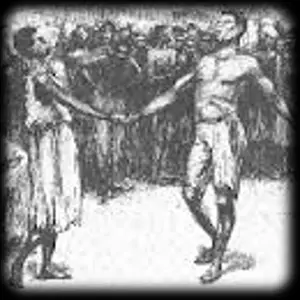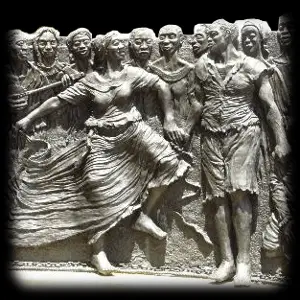CONGO SQUARE
 Congo Square, on Rampart Street in New Orleans, is a place of special significance for lovers of modern American music. A statue of ‘Satchmo’ stands in what is now called Louis Armstrong Park, near the Municipal Auditorium, and this location is the birthplace of The New Orleans Jazz and Heritage Festival. Back in the 50s, Cosimo Matassa‘s little J&M Studio across the street resounded to the music that made the world dance, as Roy Brown, Fats Domino and Smiley Lewis made their rocking records and Allen Toussaint, Dave Bartholomew and side-men like Dr. John and Earl Palmer learned their trade. Almost two Centuries previously, a different but equally spectacular kind of musical performance took place in Congo Square that brought tourists to New Orleans’ Vieux Carré, much as it does today.
Congo Square, on Rampart Street in New Orleans, is a place of special significance for lovers of modern American music. A statue of ‘Satchmo’ stands in what is now called Louis Armstrong Park, near the Municipal Auditorium, and this location is the birthplace of The New Orleans Jazz and Heritage Festival. Back in the 50s, Cosimo Matassa‘s little J&M Studio across the street resounded to the music that made the world dance, as Roy Brown, Fats Domino and Smiley Lewis made their rocking records and Allen Toussaint, Dave Bartholomew and side-men like Dr. John and Earl Palmer learned their trade. Almost two Centuries previously, a different but equally spectacular kind of musical performance took place in Congo Square that brought tourists to New Orleans’ Vieux Carré, much as it does today.
 Many instruments of African origin were played there, not just the wide variety of drums, although it was the massed drumming and wild dancing that became a tourist attraction. Stringed instruments like the ‘bania’, a three or four-stringed Senegalese lute with a calabash ‘body’, a pre-cursor of the banjo; the ‘balafon’, a wooden marimba; reed flutes and ‘quills’, and ‘one-string fiddles’ played with a bow, were among the many imported instruments to bring African melodies to New Orleans. Although the international slave trade was abolished in the early 1800s, illegal trading went on up to the Civil War, so for almost a hundred years melodies from all over West and Central Africa might have first reached American ears at Congo Square. During the rise of ‘Minstrel Music’ in the 1830s, with ‘blackface’ performers singing popular songs like ‘Jump Jim Crow’, a typical band might comprise banjo, fiddle, tambourine and ‘bones’ (polished sheep ribs), which is very close to the African ‘bania’, ‘soku’ (a bowed one-string ‘chordophone’), gourd drum and ‘bones’.
Many instruments of African origin were played there, not just the wide variety of drums, although it was the massed drumming and wild dancing that became a tourist attraction. Stringed instruments like the ‘bania’, a three or four-stringed Senegalese lute with a calabash ‘body’, a pre-cursor of the banjo; the ‘balafon’, a wooden marimba; reed flutes and ‘quills’, and ‘one-string fiddles’ played with a bow, were among the many imported instruments to bring African melodies to New Orleans. Although the international slave trade was abolished in the early 1800s, illegal trading went on up to the Civil War, so for almost a hundred years melodies from all over West and Central Africa might have first reached American ears at Congo Square. During the rise of ‘Minstrel Music’ in the 1830s, with ‘blackface’ performers singing popular songs like ‘Jump Jim Crow’, a typical band might comprise banjo, fiddle, tambourine and ‘bones’ (polished sheep ribs), which is very close to the African ‘bania’, ‘soku’ (a bowed one-string ‘chordophone’), gourd drum and ‘bones’.
